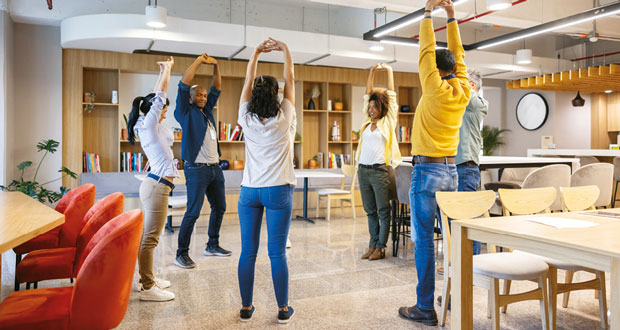THE WORKPLACE ENVIRONMENT
The physical environment plays a vital role in an individual’s wellbeing, especially when it comes to work. There is extensive research that shows the significant impact between the physical workplace environment and people’s health and wellbeing. Research from ART Health solutions found that 96 per cent of employees said a healthy work environment is crucial for productivity. Factors such as exposure to natural light, biophilic sounds and regular exercise have a hugely positive impact on one’s productivity, and physical and mental wellbeing. To accomplish this, creating greenery wherever possible in an office, such as small gardens, indoor plants, plant walls with biophilic-inspired design features, as well as simply having a view of a green space and access to outdoor areas helps employees feel more connected to the natural world- which in turn boosts employee wellbeing and overall job satisfaction.
These factors are easy to implement in an office says Lorraine Perkins from DSE Assessments, but when it comes to looking after the wellbeing of individuals working remotely, implementing and encouraging ergonomic solutions is invaluable.
Ergonomic refers to anything relating to or designed for efficiency and comfort in the working environment. Perkins states the most common ergonomic challenges faced by individuals working from home are a lack of education and awareness on good working practices, lack of support by the employer in terms of risk assessments, not having a suitable space at home to work, working long hours at a dining table and static chair, increased laptop use, and being less likely to take breaks.
INTEGRATING ERGONOMICS
Perkins describes providing a well-planned space which reflects the need for “additional flexibility to allow each worker to achieve optimum productivity”. The main ways in which ergonomics can be integrated into a workspace are:
- Environment – Exposure to natural light regulates mood and can enhance mental health and productivity.
- Ergonomic furniture – Fully adjustable furniture and equipment helps reduce physical strain and discomfort, promoting better posture and reducing the risk of musculoskeletal issues.
And additionally, in an office environment:
- Design – The aesthetic look and functionality need to align as what looks best is not always the most comfortable or adjustable. Seek ergonomic advice before committing to final choices.
- Flexible spaces – Providing quiet zones where workers can retreat for focused work to reduce stress and improve concentration, and social spaces for interaction that can create a sense of community and support mental health.
Perkins further insists the importance of the facilities manager being aware of the hybrid working policy and ensuring that it is robust enough to satisfy the company’s health and safety responsibilities. She warns it is all too common for employers to provide their employees with an allowance to equip their home office, without any guidance. As a result, poor choices are frequently made due to choosing aesthetics over comfort. This could simply be rectified by the facilities team providing an approved list of homeworking equipment to ensure it is fit for purpose.
According to Perkins there are a range of benefits that can be earned for both individuals and their organisations if they properly support and invest in the wellbeing of employees in both hybrid and remote work:
Individual
- Enhanced comfort and improved health – Ergonomic setups provide greater comfort, reducing discomfort and fatigue during long hours.
- Improved posture – Ergonomic equipment promotes proper posture, helping to prevent long-term health issues.
- Increased productivity – Staff focus better when working comfortably.
- Reduced stress – A comfortable and supportive workspace can help reduce stress and improve mental wellbeing.
- Discomfort – due to working uncomfortably can have a significant effect on personal life outside of work too.
Organisation
- Reduces the risk of absenteeism – Investing in ergonomics will lead to significant cost savings, reducing the risk of work-related injury and associated healthcare costs.
- Higher productivity – A well designed and comfortable workstation allows staff to work more efficiently with less physical strain.
- Improved quality – Comfortable and healthy employees are likely to produce high quality work and reduce errors.
- Enhanced satisfaction – If staff feel their health and wellbeing are prioritised, it can lead to higher job satisfaction leading to higher employee retention.
- Better safety culture – A strong focus on ergonomics encourages a culture of safety and wellbeing, improving morale in the workplace.
CONCLUSION
It seems that the ‘sweet spot’ for employee wellbeing lies with choice and ensuring that employees feel supported to be healthy and maximise productiveness whether based in the office or in their own homes. Two key considerations for wellbeing at work are flexibility and optionality, an acknowledgement there is never a one-size fits all solution, and that the best option is to test and learn. Making hybrid work healthy work is a joint responsibility between employees and employers, with each party accepting their obligation to contribute to a happy, healthy and motivated workforce.






